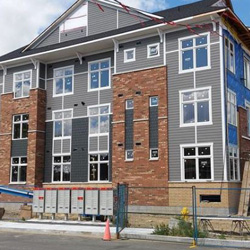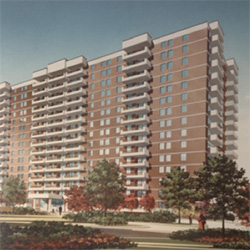There are some steps that can be taken to reduce second-hand smoke in multi-unit housing. These could include:
Document the source and extent of the problem
Use a log to track efforts to address the problem.
- Identify how smoke is entering units i.e. through a bedroom window, through a bathroom or kitchen fan or from an electrical outlet
- Identify where the smoke is coming from i.e., neighbour’s balcony or unit, outside smoking area or some other area
- Identify dates and times when smoke enters units to track how often and when smoke is a problem
- Identify when the problem started such as if smoke was a problem on date of moving in or when a new resident moved in
- If individuals are smoking in indoor common areas of multi-unit housing (lobbies, stairwell, laundry room, etc.), you can contact your local public health unit to report a violation of the Smoke-Free Ontario Act, 2017. No-smoking/no-vaping signs must be posted in all indoor common areas by provincial law.
The challenge for boards of directors dealing with second-hand smoke is to find out whether the complaint is considered a legitimate nuisance. Nuisance has a meaning in law–it is an unfair delay with the use and enjoyment of property. The second-hand smoke from a neighbour who stays in their unit all day long and chain smokes will perhaps create more of a nuisance than a neighbour who throws a couple of parties a year and invites guests who smoke.
In a 1988 Supreme Court of Ontario case (Hotel Corp. v. E.B. Eddy Forest Products Ltd.) the court recognized that “although the test of nuisance is generally whether the defendant’s use of its land interfered with the beneficial use and enjoyment of the plaintiff’s lands and whether that interference was unreasonable, there is authority for the proposition that where actual physical damage occurs, the interference is unreasonable.” To prove nuisance, it is not necessary to prove the intent, negligence or fault of the person causing the nuisance. Actual physical damage could involve second-hand smoke odour permeating soft furnishings and laminates.
Track impact of second-hand smoke
Everyone has the right to reasonable enjoyment of their home. It is important to document the amount of smoke and how often the smoke enters units and how the smoke impacts residents. Residents will want to be able to document that the smoke entering their unit makes them unable to use their unit in a normal way or makes parts of their unit uninhabitable. A log can be used to track the impact of second-hand smoke.
- Find out how the smoke is entering units. For example, the smoke could be coming from an open window, under a door, from the bathroom or kitchen fan, through an outlet or gaps between units.
- Try to find out where the smoke is coming from. For example, the smoke could be coming from a neighbouring balcony or unit or an outside smoking area.
- Track how often smoke enters a unit on a daily or weekly basis. Do you smell smoke all the time, or at certain times of the day? List dates and times that you smell smoke.
- Try to find out how much smoke is entering units. Ask: is the smell overwhelming, or is there just a whiff of smoke? Does the smoke stay in one area or does it travel to other areas of the home? Does the smoke stay in the unit for a long time or does it go away after a while?
- Think about when the problem started. Did the smell start as soon as you moved into your unit? Did you notice the smoke when a new person moved in?
Health impacts of smoke can be documented by:
- Writing down symptoms or illnesses caused by smoke, such as an asthma attack, headache, burning and watery eyes, sore throat, chronic coughing, bronchitis, ear infections and heart problems.
- Thinking about whether the smoke is making a pre-existing health problem worse. Some health problems that can be made worse by smoke include asthma, allergies, heart disease, high blood pressure, fibromyalgia, and cancer.
- Writing down whether smoke causes anxiety or fear because of the potential or actual health impacts. Babies who are exposed to second-hand smoke have a higher risk of dying from Sudden Infant Death Syndrome (SIDS), so this is important to document.
Impact on use and enjoyment of unit can be documented by asking:
- Are residents unable to live in parts of your home at times because of the smoke?
- Are residents forced to stay out of certain rooms?
- Are residents unable to open windows or balcony door?
- Are residents unable to use balconies?
- Are residents unable to use fans or heating system?
- Are residents unable to use certain cupboards, drawers or closets?
- Have residents been forced to leave home on certain days or at specific times to avoid the smoke?
- Are residents’ friends and family members with health conditions unable to visit because of the smoke?
Collect other evidence
- Check the clauses, by-laws and policies. There may be by-laws or policies already in place about behaviours or nuisances.
- Obtain written proof from neighbours, friends and family about the amount and frequency of smoke entering units.
- Get a physician or healthcare provider letter confirming that exposure to second-hand smoke makes you or your family members sick, or makes an existing condition or illness worse.
Sealing units to reduce second-hand smoke transfer
- Use caulk or spray-in foam around plumbing, electrical outlets, phone jacks, fixtures, cracks and gaps
- Close windows and doors
- Weather-strip windows and install door sweeps
- Cover or block heating/cooling grilles
- Fill or patch cracks in walls and ceilings
- Insulate air spaces around plumbing pipes
Investigating the ventilation
Make sure the ventilation system is working properly. According to the Canada Mortgage and Housing Corporation, most apartments built after the mid-1960s have corridor ventilation systems. These systems are designed to deliver outside air into corridors to maintain positive pressure. Air is continuously pushed under doors, thereby preventing odours from escaping individual units and leaking into the corridors and neighbouring apartments. Older buildings rely on air coming in through cracks and gaps for ventilation. In addition, many apartments have exhaust systems to ventilate the bathrooms and kitchens, with fans either right in individual units or located centrally elsewhere in the building.
- If smoke is entering units under the front door from other units, the property manager could check the ventilation system to make sure that it is working properly. Sometimes the systems operate on a timer and the schedule may need to be adjusted.
- Check to see if it is possible to restrict the amount of air exhausted through the ventilation system from units where there is smoking.
- If smoke is coming into units from a bathroom or kitchen fan, try the tissue test. Turn on the kitchen or bathroom fan and hold a tissue to the grille. The fan should be able to hold the tissue firmly in place. If it doesn’t, or if it blows instead of sucks, clean, repair or replace the unit.
- Clean, change or install new filters in the ventilation system.
- Restrict the amount of air exhausted through the ventilation system from units where there is smoking.
- Explore having unit pressurized to prevent air (and second-hand smoke) from leaking into the unit by having a professional install a HEPA-filtered (High Efficiency Particulate Air) heat recovery ventilation system.
- This system uses a fan to force fresh air into the unit, which prevents smoke from entering. For this system to work windows must be closed and windows and doors need to be well sealed.
- Note drawbacks to HEPA system such as expense and potential condensation problems depending on the climate. Many high-rise apartment buildings have pressurization systems in the hallways and pressuring individual units may interfere with the building ventilation system.
- Clean, change or install
While improved ventilation can remove the odour of smoke and the source of eye and throat irritation, no ventilation system can reduce exposure to the toxic chemicals in second-hand smoke to an acceptable level.
Speak with residents
- Talk to the person who is smoking. They may not realize that the smoke is a problem for you. Focus on solutions such as asking the neighbor to smoke outside.
- Share information about second-hand smoke in condo newsletters or online site for residents.
- A survey of residents about second-hand smoke exposure and interest in a no-smoking policy for the condominium could be conducted to determine how to move forward.
Speak with the condominium board
This could include:
- Discussing or asking for a discussion about a no-smoking policy (which could include declarations and rules) at the condo board of directors meeting or annual general meeting.
- A smoke-free committee could be formed to work on the issue.
If the board of directors is not supportive of moving forward with a no-smoking policy, another option is to call an owners meeting. For more information, refer to the Condominium Authority of Ontario, the Condominium Act, the Canadian Condominium Institute, or reach out to a a legal professional with expertise in condominium law.
Other steps that can be taken if second-hand smoke is an ongoing problem:
- If second-hand smoke exposure is a problem, write a complaint letter to the condominium corporation requesting they take action.
- Provide documented evidence about the source of the smoke, frequency, duration, health impact and the impact on the use and enjoyment of the unit.
- Include other supporting evidence such as a physician or healthcare provider letter about health impacts or letters from friends and neighbours that confirm the problem.
- Identify steps taken to resolve the problem to date.
- Propose possible solutions and ask for a response by a specific date (by-laws may specify a timeframe for responses to complaints).
Keep all communications with the condominium corporation, property manager or resident. If the corporation fails to act, evidence that they knew about the problem, were warned that it was a significant issue and refused to take steps to address the problem will be important.
Request condominium rule enforcement procedures be initiated
Nearly all condominium corporations have rules that ban behaviour that creates a nuisance or hazard to another person. This can include smoking, regardless of whether the condominium corporation has a formal no-smoking rule in place.
If a solution cannot be reached with the person(s) who smokes, and there is evidence that significant issues are caused by the smoke, the corporation has the authority to inform the person who smokes that they are in violation of the rules or by-laws and must stop the behaviour that is causing the problem. Condominium corporations have a duty to enforce their rules, including passing enforcement records up to and looking for help in court if necessary.
Condominium owners should also note that section 117 of the Condominium Act, 1998, “Dangerous Activities,” is a potentially useful clause that could be explored.
If a condo corporation refuses to act or smoke cannot be reduced or eliminated to a suitable level, there are a few last resort measures that can be taken. Before taking formal steps such as opening a lawsuit, it is recommended that you seek legal advice.
- Requisition (call) a meeting
- If the boardof directors is unwilling to address an issue, owners can call a meeting with written support from 15% of eligible unit owners.
- Voting on by-laws and rules at the meeting can occur, provided it follows Sections 46 – 53 of the Condominium Act, 1998.
- Initiate dispute resolution procedures
- If evidence that second-hand smoke is causing significant issues in the use and enjoyment of your home, you can try to force the condominium corporation to enforce its own clause, rules or by-laws under section 132 of the Condominium Act, 1998. Pursuant to this section of the Act, parties shall submit to mediation and arbitration to settle disagreements.
- Pursuant to section 134 of the Act, if the corporation fails to act following mediation and arbitration, condo owners can make an application to the Superior Court of Justice for an order enforcing compliance with any provision of the Act, the declaration, the by-laws or the rules.
- Condo owners also have the choice to sue the neighbour who smokes for an outcome banning the person(s) from smoking in their unit.
However, this issue is not black and white, and it is recommended that you seek legal advice if faced with applying to court to enforce a nuisance violation caused by smoking.






